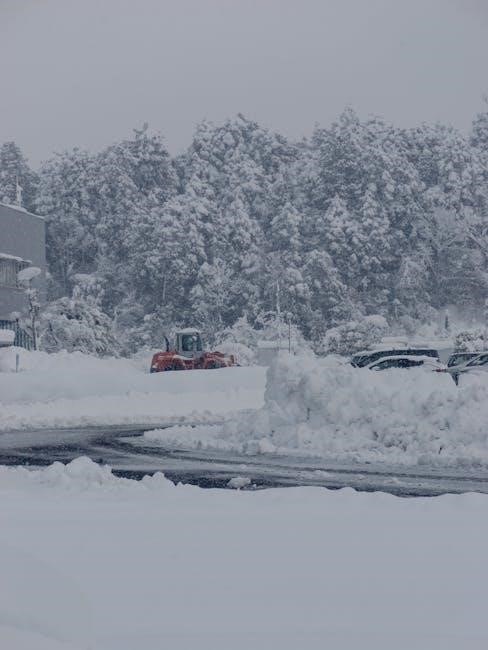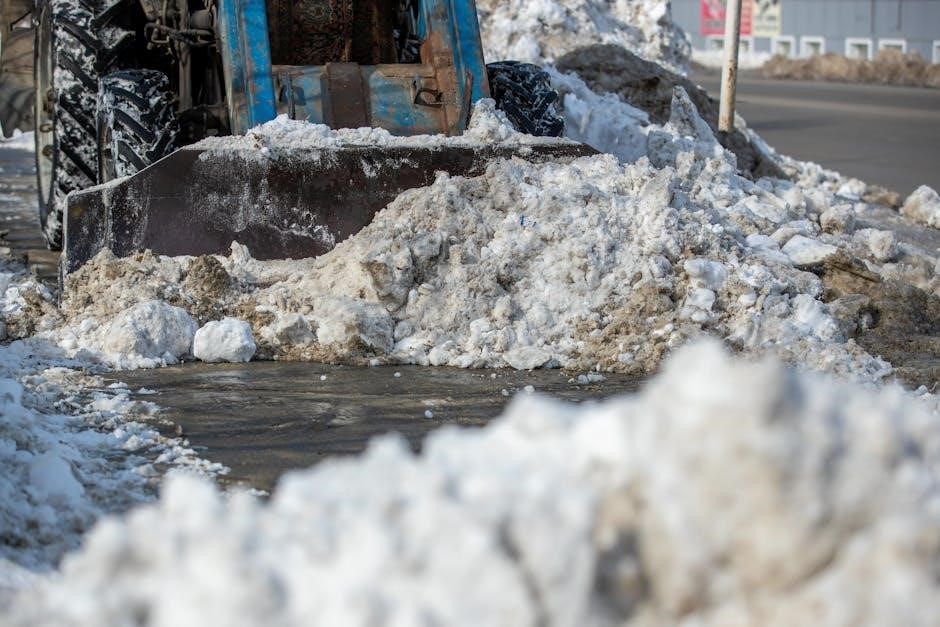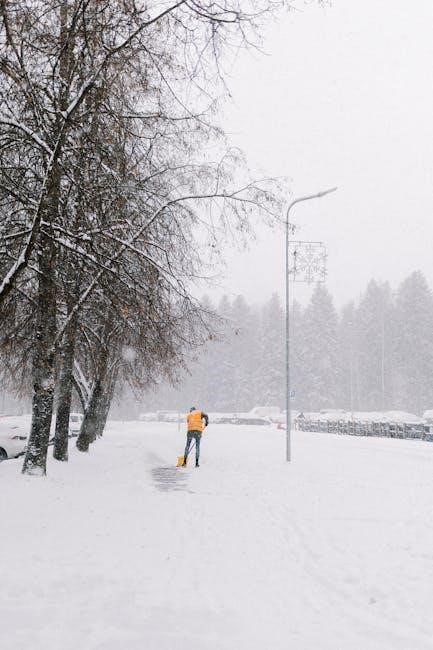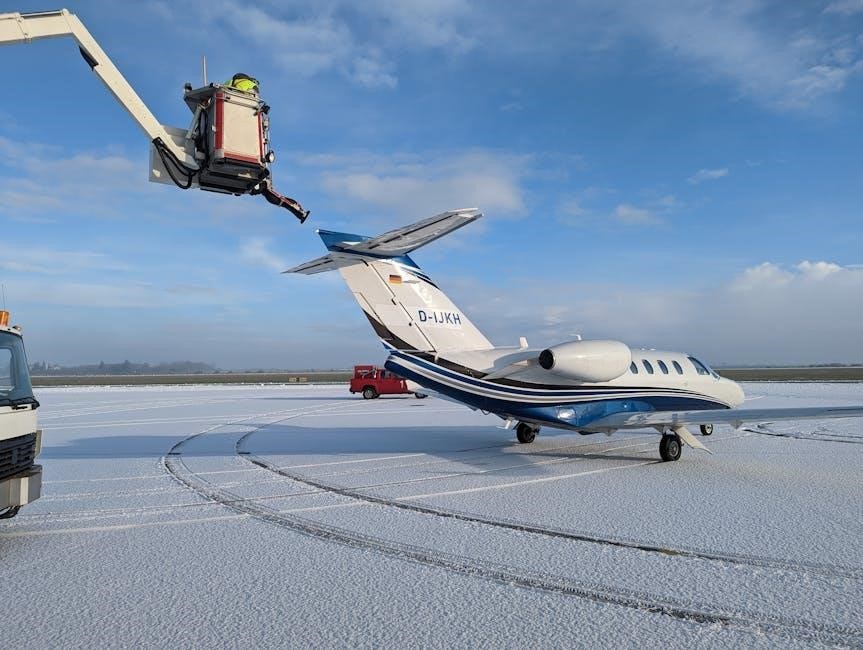A snow removal contract is a legal agreement between a client and a contractor outlining terms for snow and ice clearance services. It ensures clarity, accountability, and protection for both parties, detailing services, payment, and liability.
1.1. Overview of Snow Removal Services

Snow removal services encompass a range of activities aimed at clearing snow and ice from designated areas, ensuring safety and accessibility. These services typically include plowing driveways, parking lots, and sidewalks, as well as shoveling walkways and applying ice-melting treatments. Contractors may also offer rooftop snow removal to prevent structural damage. The scope of services varies depending on the property type, with residential contracts focusing on driveways and sidewalks, while commercial contracts often cover larger areas like parking lots and pedestrian pathways. Clear communication of services is essential to avoid misunderstandings. Liability and insurance details are also critical to protect both parties in case of accidents or property damage. A well-defined service overview ensures that clients receive the specific assistance they need during winter months.
1.2. Importance of a Snow Removal Contract
A snow removal contract is essential for outlining the responsibilities and expectations of both the service provider and the client. It ensures legal protection, clarity, and mutual understanding, preventing potential disputes. By detailing payment terms, service standards, and property specifications, the contract guarantees fair compensation for the contractor and clear obligations for the client. It also establishes liability clauses, protecting both parties in case of accidents or property damage. A well-defined contract ensures that snow removal services are performed reliably and efficiently, maintaining safety and accessibility during winter months. This formal agreement is crucial for fostering a trusting and professional relationship between the contractor and the client.

Key Components of a Snow Removal Contract
A snow removal contract must include full names, services, property details, triggers, payment terms, inspection processes, liability clauses, and termination conditions for clarity and protection.
Including the full legal names and contact details of both the client and the snow removal service provider is essential for a valid and enforceable contract. This ensures that all parties can be easily reached for communication, billing, or any disputes that may arise. The contact information should include phone numbers, email addresses, and physical mailing addresses. Clearly stating the names and details helps prevent confusion and ensures accountability. This section is fundamental in establishing professionalism and trust between the parties involved, making it a critical component of the agreement. Proper identification of both parties also aids in record-keeping and ensures smooth operations throughout the contract period. A detailed list of snow removal services is crucial to ensure clarity and avoid misunderstandings. This section should specify the exact services provided, such as driveway clearing, sidewalk shoveling, parking lot plowing, and roof snow removal. It should also outline the methods used, like plowing, snow blowing, or shoveling, and whether ice management or de-icing services are included. Additionally, the contract should clarify if services are provided per snow event or on a seasonal basis. Including specific details, such as the areas to be cleared and the frequency of service, helps set clear expectations. This section ensures both parties agree on the scope of work, preventing disputes and ensuring satisfactory service delivery. Properly defining the services is essential for a fair and transparent agreement. The property description and areas to be cleared are essential for defining the scope of work in a snow removal contract. This section should include the physical address of the property and a detailed list of areas requiring snow removal, such as driveways, sidewalks, parking lots, and walkways. It may also specify whether rooftops, decks, or other structures need attention. Including measurements or diagrams can provide clarity, ensuring both parties understand the extent of the services. This section helps prevent disputes by clearly outlining the areas covered, allowing the contractor to plan resources effectively. A precise description ensures that all agreed-upon spaces are cleared efficiently, maintaining safety and accessibility during winter conditions. This level of detail is vital for a comprehensive and enforceable agreement. The snow event trigger and response time are critical components of a snow removal contract, ensuring prompt service during winter conditions. The trigger is typically defined by a specific amount of snowfall or ice accumulation, such as 2 inches, that activates the contractor’s obligations. Response time refers to the timeframe within which the contractor must begin snow removal after the trigger is met, often ranging from 1 to 24 hours, depending on the agreement. Clearly defining these terms prevents delays and ensures property safety. Factors like weather severity, equipment availability, and priority areas may influence response times. Including these details ensures both parties understand expectations, fostering reliability and accountability during snow events. This section is vital for maintaining accessibility and safety, especially for high-traffic or sensitive locations. Compensation and payment terms in a snow removal contract outline the financial agreement between the client and contractor; This section specifies the total payment amount, payment schedule, and accepted payment methods. It may include a per-service rate, seasonal flat fee, or variable pricing based on snowfall levels. Payment terms often require a deposit upfront, with the balance due upon completion of services. Late payment fees and penalties for unpaid invoices are typically detailed to ensure timely compensation. The contract may also specify bid pricing, where rates are determined per snow event or inch of snowfall. Clear payment terms ensure transparency, avoiding disputes and ensuring fair compensation for services rendered. This section is crucial for maintaining a smooth financial relationship between both parties throughout the contract period. The client inspection and approval process ensures satisfaction with snow removal services. After each snow event, the client evaluates the work to confirm it meets agreed standards. This process may involve checking cleared areas, ensuring all designated spaces are accessible, and verifying that no damage occurred during the service. The contract typically outlines a timeframe for the client to inspect and provide feedback. If issues arise, the contractor must address them promptly at no additional cost. This process ensures quality control and maintains a positive relationship between the client and contractor. It also provides a clear mechanism for resolving any discrepancies, ensuring both parties are content with the service delivery. This step is vital for upholding service quality and client trust. Liability and insurance clauses are critical components of a snow removal contract to protect both parties in case of unforeseen events. These clauses outline the extent of the contractor’s responsibility for damages to property, injuries, or other incidents during snow removal activities. The contract typically requires the contractor to maintain adequate insurance coverage, such as general liability and workers’ compensation insurance, to cover potential risks. The client may also be protected from claims arising from the contractor’s negligence. It is essential to specify the types of insurance, coverage limits, and the requirement to provide proof of insurance before services begin. These clauses ensure financial protection and clarify responsibilities, minimizing disputes and legal complications for both the client and the contractor. Termination conditions outline the circumstances under which either party can end the snow removal contract. These clauses specify scenarios such as breach of contract, mutual agreement, or unforeseen events. Typically, termination requires written notice, with a defined period (e.g., 30 days) before the contract ends. If the contractor fails to meet service standards or violates terms, the client may terminate the agreement without penalty. Conversely, if the client defaults on payments or breaches the contract, the contractor may terminate services. The clause also details post-termination obligations, such as final payments or continued services until a replacement is found. Clear termination conditions protect both parties by providing a structured exit process and minimizing potential disputes. Snow removal contract templates provide a structured format to create legally binding agreements, ensuring all essential details are included. They streamline the drafting process, saving time and effort. Snow removal contract templates are widely available online, offering convenience for both contractors and clients. Official government or municipal websites often provide standardized templates tailored to local regulations. Legal document platforms like LegalZoom and LawDepot offer customizable templates designed to meet specific needs. Additionally, professional associations, such as Landscape Ontario, provide industry-specific templates that include detailed clauses for snow and ice maintenance. Many contractor websites also offer downloadable templates as part of their services. Online marketplaces like Microsoft Office and Google Docs feature editable templates that can be adapted to individual requirements. These resources ensure that users can easily find and customize a template to suit their needs, saving time and ensuring compliance with legal standards. Customizing a snow removal contract PDF involves tailoring the template to meet specific needs. Start by using PDF editing software like Adobe Acrobat or free tools like Smallpdf. Fill in the client and contractor details, including names, addresses, and contact information. Clearly outline the scope of services, such as driveways, sidewalks, or parking lots. Specify the payment terms, including rates, due dates, and accepted methods. Define triggers for snow removal, like snow depth thresholds, and include response times. Add liability clauses and insurance details to protect both parties. Ensure all clauses are clear and specific to avoid disputes. Finally, save and share the document for e-signature using platforms like DocuSign or PandaDoc. Regularly review and update the contract to reflect any changes in services or terms. Legal considerations ensure contracts comply with local laws, outlining liability, insurance, and payment terms while protecting both parties from disputes. The contract period in a snow removal agreement specifies the start and end dates of the service, often aligning with the winter season. Renewal options are typically outlined, allowing both parties to continue the agreement without renegotiation. Automatic renewal clauses are common, requiring written notice to terminate before the next season. Contracts may also include terms for early termination or mutual agreement to extend services. It is essential to define the renewal process clearly to avoid disputes. Additionally, the agreement should specify how changes in service scope or pricing will be handled upon renewal. Ensuring both parties understand the terms prevents misunderstandings and maintains a smooth working relationship. Properly structured renewal clauses protect both the client and contractor, ensuring continuity of service and fair compensation. Legal compliance is crucial to uphold the agreement’s validity. Snow removal contracts must comply with local, state, and federal regulations to ensure legal and ethical operations. These regulations may include permits for equipment usage, environmental rules for chemical de-icers, and timelines for sidewalk clearance. Contractors must adhere to noise ordinances, especially in residential areas, and follow safety standards during snow removal. Additionally, compliance with labor laws is essential, ensuring fair wages and safe working conditions. Failure to meet these requirements can result in fines or contract termination. Both parties should review and understand local regulations to avoid legal disputes. Including a clause that addresses compliance ensures accountability and protects both the client and contractor from potential penalties. Proper adherence to regulations fosters trust and maintains the integrity of the snow removal services provided. Compliance is a critical aspect of a legally binding and effective snow removal contract. When drafting a snow removal contract, ensure clarity, specificity, and thoroughness. Include clear service descriptions, payment terms, and liability clauses. Regular legal reviews are essential to avoid disputes. Clarity and specificity are crucial in service descriptions within a snow removal contract. Clearly outline the areas to be cleared, such as driveways, parking lots, and sidewalks, and specify the methods used, like plowing, shoveling, or salting. Define what constitutes a snow event and the expected response time. Include details about the equipment and materials used to ensure quality service. Avoid vague terms that could lead to misunderstandings. For instance, instead of stating “snow removal,” specify if it includes ice melting or sanding. This ensures both parties have a clear understanding of the scope and expectations, reducing the likelihood of disputes. Regular updates and reviews of these descriptions are recommended to adapt to changing client needs or property conditions. A detailed payment schedule is essential to avoid disputes and ensure timely compensation. Specify the total cost, payment methods, and due dates. Break down payments into installments or per service, clearly stating amounts and deadlines. Outline penalties for late payments and incentives for early settlements. Include a deposit or retainer if required. Define the payment structure, whether it’s a flat rate, per snow event, or hourly. Ensure clarity on what each payment covers, such as equipment, labor, or materials. Provide instructions for delivering payments, like mailing checks or online transfers. This transparency builds trust and ensures smooth financial transactions throughout the contract period. Regularly review and update the schedule to reflect any changes in services or rates. Neglecting liability clauses and unclear snow event triggers are common errors. Ensure all terms are specific to avoid misunderstandings and potential legal disputes. Neglecting liability and insurance clauses can expose both parties to significant risks. A snow removal contract must clearly outline who is responsible for damages or injuries during services. Insurance details, such as coverage limits and provider information, should be explicitly stated to protect against unforeseen incidents. Without these provisions, either party could face legal or financial repercussions if accidents occur. Including liability and insurance information ensures transparency and accountability, safeguarding both the contractor and client throughout the agreement. This section is crucial for minimizing potential disputes and ensuring a smooth resolution process if issues arise during snow removal operations. Always prioritize clarity and comprehensiveness in these details to avoid future complications. Failing to clearly define snow event triggers is a common mistake in snow removal contracts. A snow event trigger specifies the conditions under which snow removal services will be initiated, such as a certain accumulation of snow or specific weather forecasts. Ambiguity in this area can lead to disputes over when services should begin, potentially delaying necessary work. Clearly outlining triggers ensures both parties understand their responsibilities and expectations. It also helps avoid conflicts regarding service activation, response times, and the scope of work. Including specific thresholds, such as inches of snowfall or timeframes for service commencement, provides clarity and prevents miscommunication. This section is vital for ensuring timely and effective snow removal operations. Always prioritize clear, measurable criteria to avoid confusion and ensure smooth execution of the agreement.2.1. Full Names and Contact Information of Both Parties
2.2. List of Snow Removal Services
2.3. Description of Property and Areas to Be Cleared
2.4. Snow Event Trigger and Response Time

2.5. Compensation and Payment Terms
2.6. Client Inspection and Approval Process
2.7. Liability and Insurance Clauses
2.8. Termination Conditions

Understanding Snow Removal Contract Templates
3.1. Where to Find Snow Removal Contract Templates


3.2. How to Customize a Snow Removal Contract PDF

Legal Considerations in Snow Removal Contracts
4.1. Contract Period and Renewal Options
4;2. Compliance with Local Regulations
Best Practices for Drafting a Snow Removal Contract
5.1. Clarity and Specificity in Service Descriptions
5.2. Including a Detailed Payment Schedule

Common Mistakes to Avoid in Snow Removal Contracts

6.1. Overlooking Liability and Insurance Details
6.2. Not Defining Snow Event Triggers Clearly
